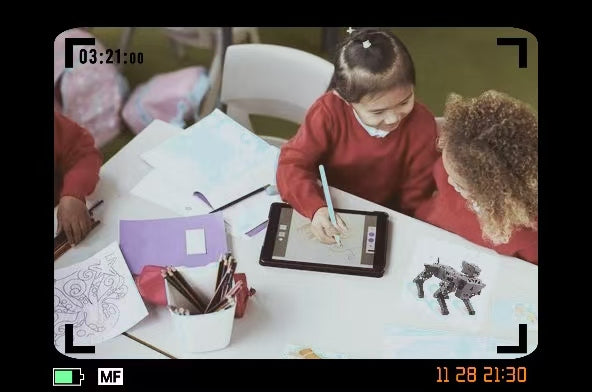With the rapid development of technologies such as artificial intelligence, the Internet of Things and big data, the importance of programming education has become increasingly prominent. Especially in the K-12 education stage, programming is not only regarded as a basic skill, but also a key tool for cultivating students' innovative thinking and problem-solving ability. In order to help students learn programming better, educational programming robots came into being. These robots not only provide students with a vivid learning environment, but also have a variety of characteristics and a wide range of practical applications. Next, we will explore the characteristics and practical applications of educational programming robots in depth, and provide some suggestions for choosing educational programming robots.
1. Characteristics of educational programming robots
Strong interactivity
The interactivity of educational programming robots enables students to learn through practice and feedback, which enhances their sense of participation. According to statistics from ResearchAndMarkets, interactive learning platforms can improve students' learning efficiency by up to 60%.
Diverse learning methods
Educational programming robots usually provide a variety of learning paths and programming language options. Studies have shown that students who use graphical programming tools have a 30% higher success rate in understanding basic programming concepts than students who use traditional text programming languages.
Combination of practicality and fun
Educational programming robots are centered on practice. According to relevant surveys, 82% of students believe that learning programming in practice is more effective than pure theoretical learning. Project-based learning improves students' motivation and interest, making them more proactive when facing real problems.
Cultivation of teamwork and communication skills
Educational programming robot projects usually require teamwork to complete. Data show that students who participate in team projects have improved their communication and collaboration skills by 39% compared with students who study independently.
Strong adaptability
Educational programming robots can adjust according to students' learning progress. Studies have shown that students who use adaptive learning software have an average improvement of more than 30% in learning effects, thus achieving teaching in accordance with their aptitude.
2. Practical application of educational programming robots
Basic programming education
In the K-12 education system, programming education has become a compulsory course. The number of students participating in computer science courses has increased by 40% in the past five years. Educational programming robots can be used as the main tool for these courses.
STEM education
STEM education continues to be valued, and educational programming robots can combine these fields well. Among the students participating in the robot competition, 93% of them expressed a significant increase in interest in the STEM field.
Maker education
Maker education emphasizes practice and creation. According to a survey by the Pew Research Center, 68% of students who participated in maker projects said that they improved their innovation ability through hands-on practice.
Special education
Educational programming robots can be used in special education. Studies have shown that the learning effect of special education students has improved by 25%, especially in self-expression and social skills.
Extracurricular programming activities
In extracurricular activities, 85% of students who participated in programming summer camps said that their understanding of programming has deepened and they hope to continue to participate. It not only broadens their horizons, but also enhances their practical ability.
3. How to choose an educational programming robot
When choosing an educational programming robot, you need to consider multiple factors to ensure that the selected tool can effectively meet the learning needs of students. Here are some key selection guidelines:
Clear educational goals
First, clarify the main goal of using educational programming robots. Is it for basic programming teaching, STEM education, or maker education? Choose the appropriate robot type and function according to specific needs.
Age and ability adaptation
Choose programming robots suitable for different age groups and ability levels. For beginners, graphical programming robots (such as LEGO WeDo and Bee-Bot) may be more suitable. For students with a certain foundation, more complex programming tools (such as Arduino or Raspberry Pi) can be selected.
Programming language and tools
Consider whether the programming language and tools used by educational programming robots are suitable for students' learning curve. For example, Scratch, as a graphical programming tool, is very suitable for beginners, while Python is suitable for students who want to learn programming in depth.
Scalability and flexibility
Choose a robot with strong scalability so that it can support different projects and tasks. For example, some robots can be used with sensors, motors and other hardware, which increases the depth and fun of learning.
Support and resources
Good educational programming robots usually come with rich learning resources, including curriculum design, sample projects and community support. When choosing, you can check the tutorials, learning materials and support platforms provided by educational robot manufacturers.
Budget considerations
The prices of educational programming robots vary greatly, and the most suitable equipment should be selected according to the budget of the school or institution. The long-term cost of additional accessories or software updates also needs to be considered.
User reviews and feedback
Check the reviews and feedback of other educators and users before making a final decision. Through the experience of existing users, we can better understand the actual performance and application effect of the robot.
IV. Conclusion
Educational programming robots provide students with a vivid learning environment, enabling them to master programming knowledge and skills in practice. Through flexible teaching design and interesting projects, educational programming robots not only enhance students' learning interest and hands-on ability, but also pave the way for their future career development. With the advancement of technology and the continuous updating of educational ideas, educational programming robots will play a more important role in future education. It is particularly important to choose the right educational programming robot to ensure that students can get the best learning experience and results.
Characteristics, practical applications and selection guide of educational programming robots

